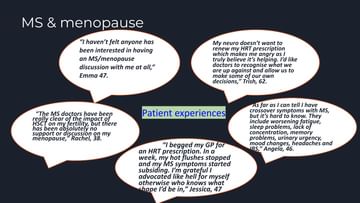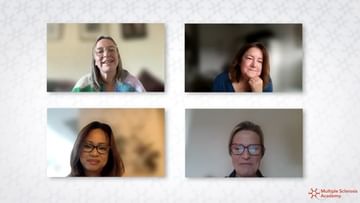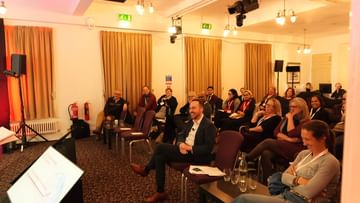‘Getting it right first time (GIRFT)’ - using data to improve clinical services
The national GIRFT programme was established by NHS Improvement in partnership with Royal National Orthopaedic Hospital NHS Trust and seeks to improve the quality of care within the NHS by reducing unwarranted variations. Dr Geraint Fuller leads on the neurology workstream and on 2nd November he presented to the ‘MS Services: the Way Forward’ conference the impact he hopes the programme will have on the variation in MS services.
 The decision in unpicking the data for GIRFT has been to look at ‘neuroscience regions.’ This is essentially the region with a hub and spoke model of care in it – neuroscience centres and the DGHs that feed into it. By doing this, there are reasonably comparable populations each comprising a number of similar models of care, mapped across the country to benchmark against. The plan is to hold meetings in each of these neuroscience regions to provide attendees with their local data as compared to another similarly populated region.The data for neurology is being gathered from a wide range of sources including the national census, Hospital episodic statistics (HES), specialised commissioning, and personnel spread. How many MS nurses there are in post, how many people are being admitted to hospital and for how long; how many day case admissions are there, and how many of these are within neurology as a first code, and much more.
The decision in unpicking the data for GIRFT has been to look at ‘neuroscience regions.’ This is essentially the region with a hub and spoke model of care in it – neuroscience centres and the DGHs that feed into it. By doing this, there are reasonably comparable populations each comprising a number of similar models of care, mapped across the country to benchmark against. The plan is to hold meetings in each of these neuroscience regions to provide attendees with their local data as compared to another similarly populated region.The data for neurology is being gathered from a wide range of sources including the national census, Hospital episodic statistics (HES), specialised commissioning, and personnel spread. How many MS nurses there are in post, how many people are being admitted to hospital and for how long; how many day case admissions are there, and how many of these are within neurology as a first code, and much more. Fig 1: Proportion of medication spend by provider[/caption]Geraint showed this graph as a clear demonstration of the variation in prescribing practices, but asked the room some pertinent questions. At a meeting looking to end variance in MS services, he asked ‘Are there good reasons for this variance? Do we want to see clean lines, or is some variation a good thing? What part of this graph do we want? Which are the good bits? Which do we want – and how do we know?’In summary, Geraint suggested that reducing variation is not always the best way to optimise services.
Fig 1: Proportion of medication spend by provider[/caption]Geraint showed this graph as a clear demonstration of the variation in prescribing practices, but asked the room some pertinent questions. At a meeting looking to end variance in MS services, he asked ‘Are there good reasons for this variance? Do we want to see clean lines, or is some variation a good thing? What part of this graph do we want? Which are the good bits? Which do we want – and how do we know?’In summary, Geraint suggested that reducing variation is not always the best way to optimise services.
When we know better, we do better
GIRFT essentially uses data to help improve clinical outcomes, and Dr Fuller began by highlighting that the evidence at the start of the GIRFT programme suggested people were not aware of their own data. ‘We don’t know what we don’t know’ and ‘When we know better, we do better’ are both common enough phrases, with plenty of truth in them, and when put together, they outline the crux of Geraint’s presentation. He shared that the GIRFT programme found that once Trusts and clinicians alike were presented with their own data they began to make vast improvements. The expectation across the various workstreams is that the same thing will ring true.Success is not something that occurs immediately, but gradually, ‘We don’t really get it right first time, we get a bit right, then try to make the next bit right, and we keep trying new things’ said Geraint. The hope of the programme is that this can change and we can ‘get it right first time.’

The challenges
So the work in getting neurology right first time lies in looking at our data and changing what we are doing, but Geriant pointed out that therein lies the biggest challenge:‘A large proportion of work in neurology is not recorded in data’.The next challenge is the myriad models of service provision across the country. From neuroscience centres to district general hospitals (DGH), neurology centres to hospitals without their own consultants, there are many models of provision with differing numbers of consultants and registrars, different treatments available, different numbers of beds. This makes both unpicking the data, and later, comparing it, difficult.Then there is the spectrum of different neurological disorders which all require different approaches to care, from rapid access close to home for motor neurone disease, to a potential need for surgery with Parkinson’s or epilepsy, to MS where individuals might prefer to seek out and travel to centres of excellence.
The solutions
 The decision in unpicking the data for GIRFT has been to look at ‘neuroscience regions.’ This is essentially the region with a hub and spoke model of care in it – neuroscience centres and the DGHs that feed into it. By doing this, there are reasonably comparable populations each comprising a number of similar models of care, mapped across the country to benchmark against. The plan is to hold meetings in each of these neuroscience regions to provide attendees with their local data as compared to another similarly populated region.The data for neurology is being gathered from a wide range of sources including the national census, Hospital episodic statistics (HES), specialised commissioning, and personnel spread. How many MS nurses there are in post, how many people are being admitted to hospital and for how long; how many day case admissions are there, and how many of these are within neurology as a first code, and much more.
The decision in unpicking the data for GIRFT has been to look at ‘neuroscience regions.’ This is essentially the region with a hub and spoke model of care in it – neuroscience centres and the DGHs that feed into it. By doing this, there are reasonably comparable populations each comprising a number of similar models of care, mapped across the country to benchmark against. The plan is to hold meetings in each of these neuroscience regions to provide attendees with their local data as compared to another similarly populated region.The data for neurology is being gathered from a wide range of sources including the national census, Hospital episodic statistics (HES), specialised commissioning, and personnel spread. How many MS nurses there are in post, how many people are being admitted to hospital and for how long; how many day case admissions are there, and how many of these are within neurology as a first code, and much more.What the data is showing us
Initial headlines from the data include that the cost is no more or less in a neuroscience centre than a DGH. It has also highlighted huge variation in the amount of services and treatment being funded by specialised commissioning. As always, data asks as many questions as it answers, but it gives us a direction to start looking in – are there coding issues with specialised commissioning, or are there different ways of providing those services in different patches? Is there an issue with access to certain services, or in availability?When unpicking the data around medication, questions asked were around where the spend is allocated, how much people spend and what drugs do they spend it on. The findings present a huge variation in drug prescribing (fig 1). (At a glance, the variation is clear; the width of bar indicates the amount of people being treated, the red drugs are more efficacious, the blue less.)[caption id="attachment_3727" align="alignnone" width="850"] Fig 1: Proportion of medication spend by provider[/caption]Geraint showed this graph as a clear demonstration of the variation in prescribing practices, but asked the room some pertinent questions. At a meeting looking to end variance in MS services, he asked ‘Are there good reasons for this variance? Do we want to see clean lines, or is some variation a good thing? What part of this graph do we want? Which are the good bits? Which do we want – and how do we know?’In summary, Geraint suggested that reducing variation is not always the best way to optimise services.
Fig 1: Proportion of medication spend by provider[/caption]Geraint showed this graph as a clear demonstration of the variation in prescribing practices, but asked the room some pertinent questions. At a meeting looking to end variance in MS services, he asked ‘Are there good reasons for this variance? Do we want to see clean lines, or is some variation a good thing? What part of this graph do we want? Which are the good bits? Which do we want – and how do we know?’In summary, Geraint suggested that reducing variation is not always the best way to optimise services.‘Variation drives evolution. Sometimes, variation can give us an evolutionary advantage’, he said in closing.As we try to reduce unwanted variance in MS services, we need to ensure we do not remove the opportunity for variation where the reason for it is to improve care and support for people living with MS.
Watch this presentation:
https://youtu.be/XjNVcmpBGf4 → More videos from this eventListen to this presentation:
→ More podcasts from this eventMore information
- For more information on the GIRFT programme, visit the website.
- Read our Spotlight article on the project hoping to be picked up by GIRFT about disease-modifying treatments and the cost associated with good care.
- More spotlight articles for an in-depth look at some of the key issues raised at the Variance event
- Register for our follow-up meeting 2019: MS Service Provision in the UK 2019; Raising the Bar
Related articles
Encouraging excellence, developing leaders, inspiring change
MS Academy was established five years ago and in that time has accomplished a huge amount. The six different levels of specialist MS training are dedicated to case-based learning and practical application of cutting edge research. Home to national programme Raising the Bar and the fantastic workstream content it is producing, this is an exciting Academy to belong to.


